Cappadocia, located in Turkey’s Central Anatolia Region, is a world-renowned tourist destination famous for its unique natural formations, historical structures, and mystical atmosphere. The fairy chimneys, formed by the erosion of tuff layers created by volcanic eruptions millions of years ago through wind and water, are among the most striking symbols of the region. Throughout history, Cappadocia has been home to many civilizations such as the Hittites, Persians, Romans, and Byzantines. This deep-rooted past makes the region worth exploring not only for its natural beauty but also for its rich history.
Among the places to visit in Cappadocia, the Göreme Open-Air Museum, Uçhisar Castle, underground cities like Derinkuyu and Kaymaklı, and historic towns such as Avanos, Ürgüp, and Mustafapaşa stand out. In addition, experiences such as hiking through the valleys, hot air balloon tours, and staying in cave-carved hotels offer unforgettable moments to visitors. Walking through Cappadocia’s stone-paved streets, seeing centuries-old churches, and watching the sunrise among floating balloons are just a few elements of the magical atmosphere this unique geography has to offer.
1. Cappadocia National Park
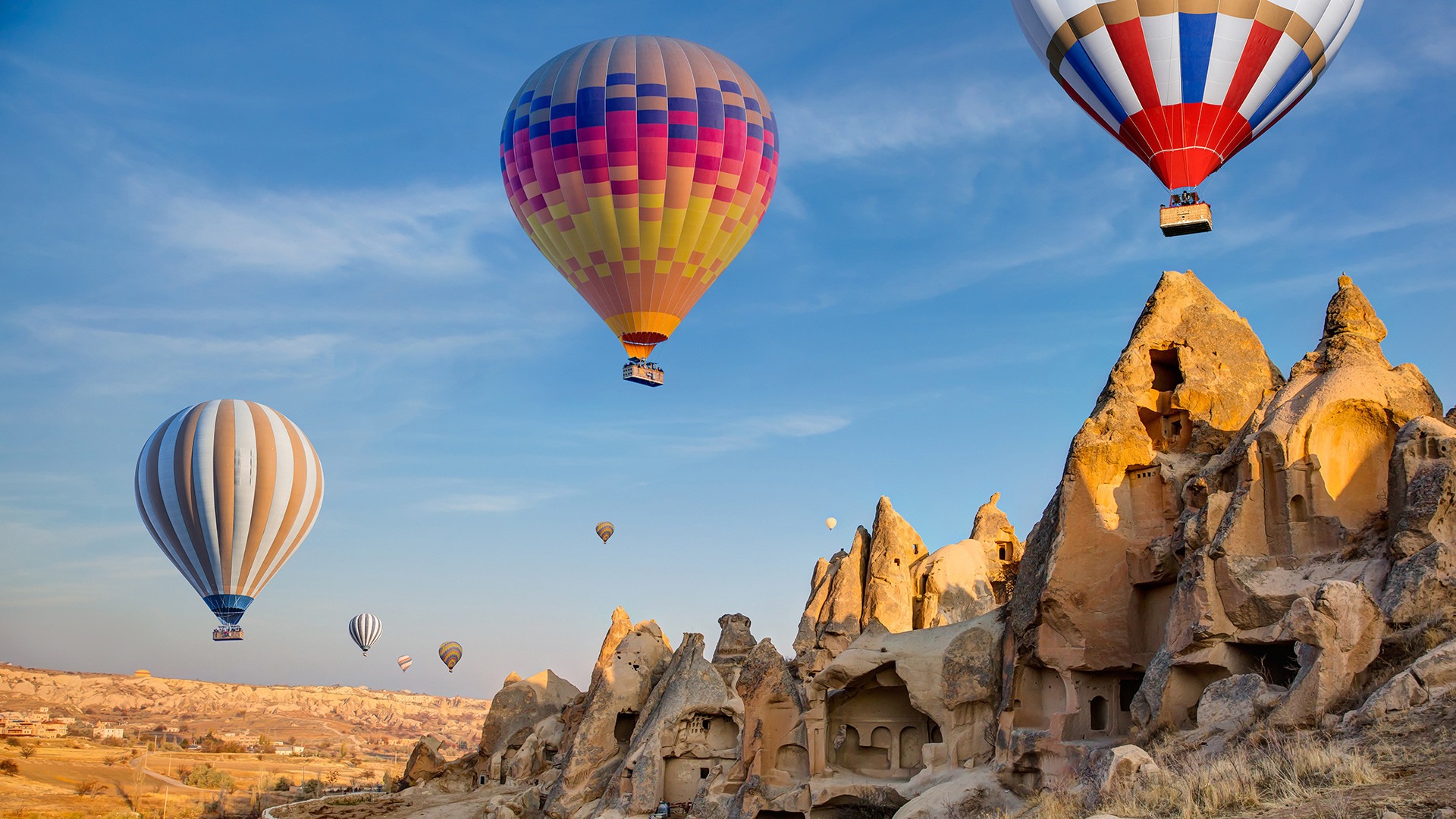
Cappadocia National Park was included in the UNESCO World Heritage List in 1985 and is considered one of Turkey’s most important natural and cultural heritage sites. Located within the borders of Nevşehir Province, the park primarily covers Göreme and its surroundings. The unique fairy chimneys, rocky valleys, and natural formations created by the erosion of volcanic tuff over millions of years are the main attractions of the park.
The park stands out not only for its natural beauty but also for its historical and archaeological richness. Churches, monasteries, living spaces, and underground cities carved into the rocks shed light on Cappadocia’s thousands of years of history. The Göreme Open-Air Museum is one of the most important parts of the park and is known for its rock-cut churches adorned with Byzantine-era frescoes. Cappadocia National Park is an ideal destination for nature walks, photography, balloon tours, and cultural exploration.
2. Uçhisar Castle

Uçhisar Castle is the highest point in the Cappadocia region and is located in the town of Uçhisar, within Nevşehir Province. This impressive structure is a natural rock formation that has been used throughout history as a strategic defense and observation point. The castle is filled with interconnected tunnels, rooms, and shelters, and it once housed thousands of people.
From the top of the castle, visitors can enjoy a panoramic view of Cappadocia’s unique landscape. Especially at sunset, the valleys and fairy chimneys of the region take on a mesmerizing appearance. Uçhisar Castle is a must-visit destination for both history enthusiasts and nature lovers.
3. Göreme Open-Air Museum

Göreme Open-Air Museum is located 2 kilometers east of the town of Göreme in Nevşehir and is one of the most important historical and cultural sites in the Cappadocia region. This area hosted an intense monastic life from the 4th to the 13th century AD and is notable for its rock-carved churches, chapels, dining halls, and living quarters. It has been on the UNESCO World Heritage List since 1985.
Within the museum are significant structures such as the Monastery of Girls and Boys, the Church of Saint Basil, Elmalı Church, the Church of Saint Barbara, the Snake Church, the Dark Church, the Church with Sandals, and Tokalı Church. The walls of these churches are adorned with frescoes depicting scenes from the Bible and the life of Jesus Christ. With its structures shedding light on the early history of Christianity and its artistic richness, the Göreme Open-Air Museum offers visitors a truly unique experience.
4. Derinkuyu Underground City
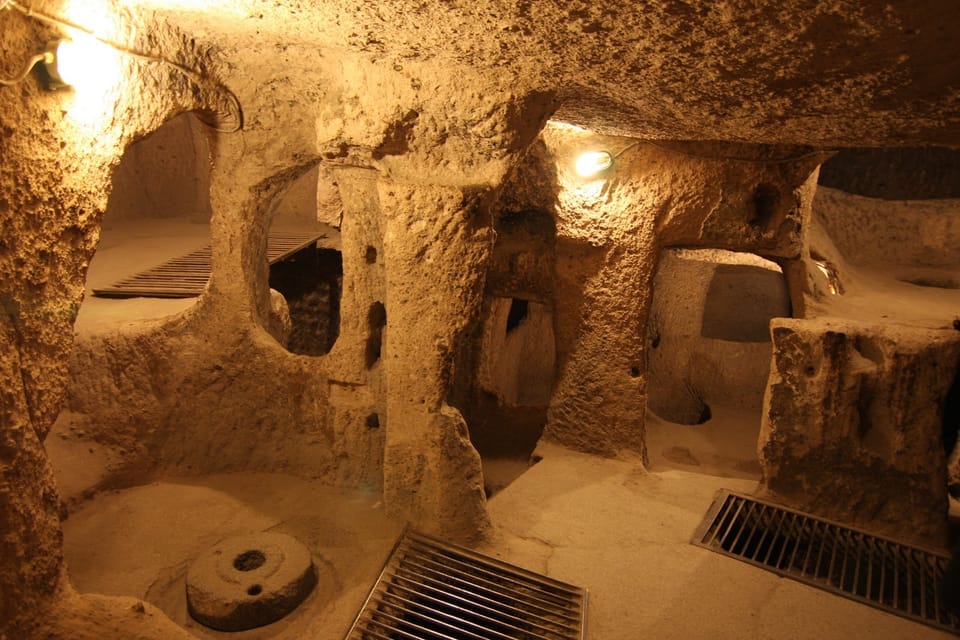
Derinkuyu Underground City, located in the Derinkuyu district of Nevşehir Province, is one of the largest underground cities in the Cappadocia region. This structure reaches a depth of approximately 85 meters and has 13 levels, with the capacity to accommodate up to 20,000 people in the past.
Discovered by chance during a house renovation in 1963, Derinkuyu Underground City was opened to visitors in 1967. The city contains numerous living spaces such as stables, cellars, dining halls, churches, and wineries. The missionary school on the second level is notable for its barrel-vaulted ceiling.
One of the most striking features of Derinkuyu Underground City is its narrow tunnels connecting the levels and massive stone doors used for security. In addition, the 55-meter-deep ventilation shaft not only provided air circulation but also served as a water well.
Used by various civilizations throughout history, this underground city served especially during the Byzantine period as a shelter from Arab invasions. Today, Derinkuyu Underground City is one of the most important tourist attractions in Cappadocia, welcoming numerous visitors.
5. Ihlara Valley
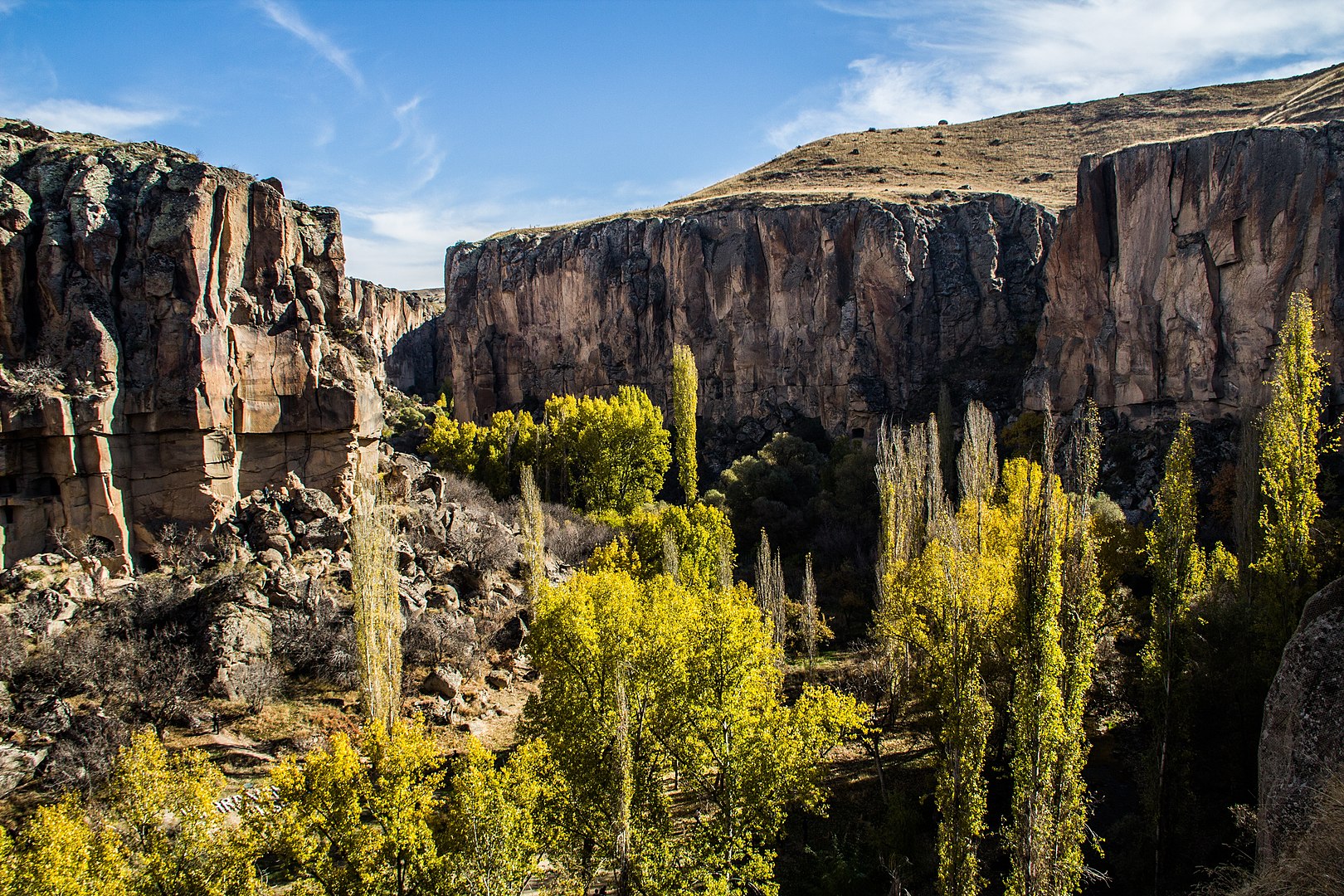
Ihlara Valley is located within the borders of Güzelyurt district in Aksaray Province, Turkey, and is a canyon renowned for its natural and historical richness. Approximately 18 kilometers long, 150 meters deep, and 200 meters wide, this canyon was formed by the erosion of the Melendiz River over thousands of years.
One of the most striking features of the valley is the presence of around 50 churches and countless living spaces carved into the rocks. These structures were especially used during the early Christian period by monks and priests in the region. Significant buildings such as the Church of Ağaçaltı, the Snake Church, and the Church of Sümbüllü attract visitors with their frescoes and architecture.
Ihlara Valley is a unique destination for nature walks and history enthusiasts. Along the Melendiz River, visitors can explore the valley’s natural beauty while also viewing its historical structures. The main entrance to the valley is usually from the town of Ihlara, where a staircase of approximately 400 steps leads down to the valley floor.
Additionally, thanks to the valley’s microclimate, it hosts a rich variety of flora and fauna, in contrast to the surrounding steppe vegetation. With these features, Ihlara Valley is one of the must-see places for lovers of nature and history.
6. Paşabağ (Valley of the Monks)
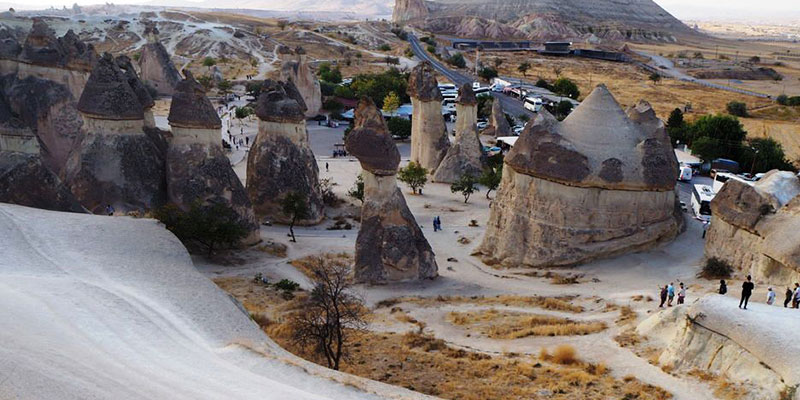
Paşabağ Valley, also known as the Valley of the Monks, is located near the town of Avanos in Cappadocia, along the Göreme–Avanos road, and is famous for its unique fairy chimneys. This valley is particularly known for its multi-headed, mushroom-shaped fairy chimneys and contains some of the most characteristic natural formations in Cappadocia.
Throughout history, especially during the Byzantine period, it was used as a retreat for monks and hermits. The valley contains chapels and hermit cells carved into the rocks. The most notable of these is a chapel dedicated to Saint Simeon, carved into a three-headed fairy chimney.
Paşabağ Valley offers visitors the chance to closely observe the formation process of fairy chimneys. Here, one can see fairy chimneys in various stages—those still forming, fully formed, and those eroding away.
This valley is a must-see for anyone visiting Cappadocia and is also an ideal spot for nature walks and photography. Additionally, you can take a break at one of the valley’s cafés and enjoy the peaceful atmosphere of the area.
7. Avanos
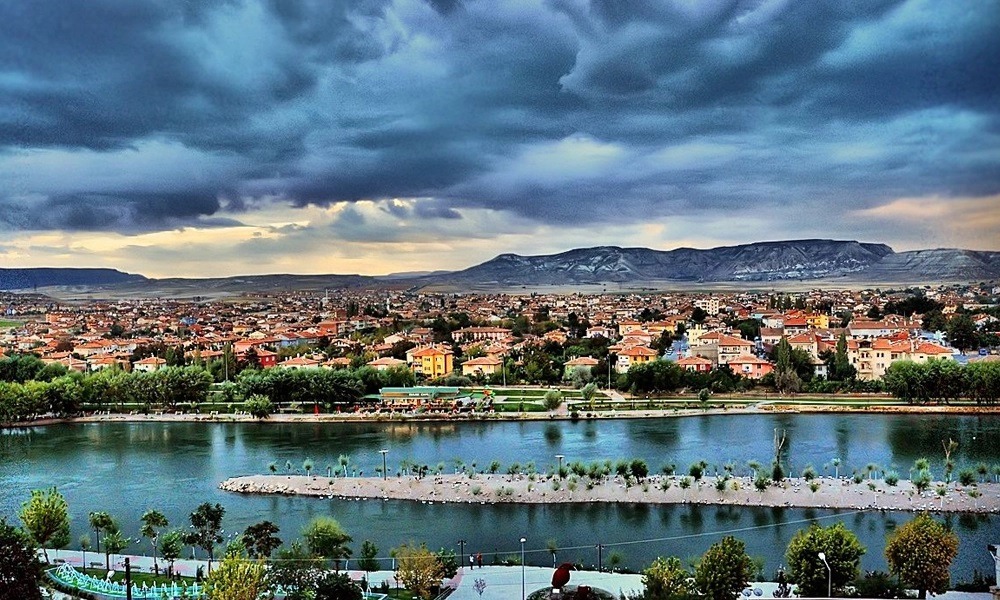
Avanos is a historic and touristic district in the Cappadocia region, located in Nevşehir Province, Turkey. The town lies on the banks of the Kızılırmak River (Red River) and is especially famous for its pottery and ceramic arts. The red clay brought by the river has been used for centuries by the craftsmen of Avanos in pottery making.
Places to Visit
- Pottery Workshops: Many pottery workshops are located in the center of Avanos. Visitors can watch the craftsmen at work and even try making their own pottery.
- Chez Galip Hair Museum: Considered one of the world’s most unusual museums, it has displayed hair samples left by visitors since 1979.
- Güray Museum: The world’s first and only underground ceramic museum, Güray Museum showcases the history and evolution of ceramic art.
- Kızılırmak River and Suspension Bridge: You can take a walk along the river, cross the suspension bridge, and enjoy the surrounding scenery.
- Zelve Open-Air Museum: Located about 5 km from Avanos, this museum is one of the oldest settlements in Cappadocia and is known for its rock-carved churches and monasteries.
Activities
- Hot Air Balloon Tours: These tours are popular among those who want to witness Cappadocia’s unique landscape from the sky.
- Horse and ATV Tours: These tours are ideal for adventure seekers wanting to explore the region’s natural beauty.
- Riverside Walks and Boat Tours: You can walk along the Kızılırmak River or join a boat tour to experience the surroundings from a different perspective.
Accommodation
Avanos offers accommodation options for every budget, including international hotel chains and boutique hotels.
Food & Drink
The district features restaurants serving both traditional Turkish cuisine and international dishes. Dining at riverside restaurants is a great way to enjoy the view.
With its historical texture, cultural richness, and natural beauty, Avanos is one of the must-see spots in Cappadocia.
8. Zelve Valley

Zelve Valley is one of the oldest and longest-inhabited settlements in the Cappadocia region, located about 5 kilometers from the Avanos district of Nevşehir Province. Comprising three valleys, this area is especially notable for its sharp-pointed and broad-based fairy chimneys.
Throughout history, Zelve served as a significant religious center, and between the 9th and 13th centuries, it was a hub of monastic life for Christians. Important structures in the valley include the churches of Balıklı, Üzümlü, and Geyikli. Additionally, a rock-carved mosque, mill, and tunnels reflect the valley’s rich historical heritage.
Zelve Valley remained inhabited until 1952 but was evacuated due to the risk of rockfalls. It was opened to visitors as an open-air museum in 1967. Today, visitors can explore rock-carved structures, churches, and fairy chimneys, while also enjoying the natural beauty of the valley.
Those wishing to visit Zelve Valley can reach it via a roughly 15-kilometer drive from Nevşehir city center. Museum Pass is valid for entry, and visiting hours may vary by season. For a comfortable visit, it is recommended to wear season-appropriate clothing and comfortable shoes.
9. Ortahisar Castle
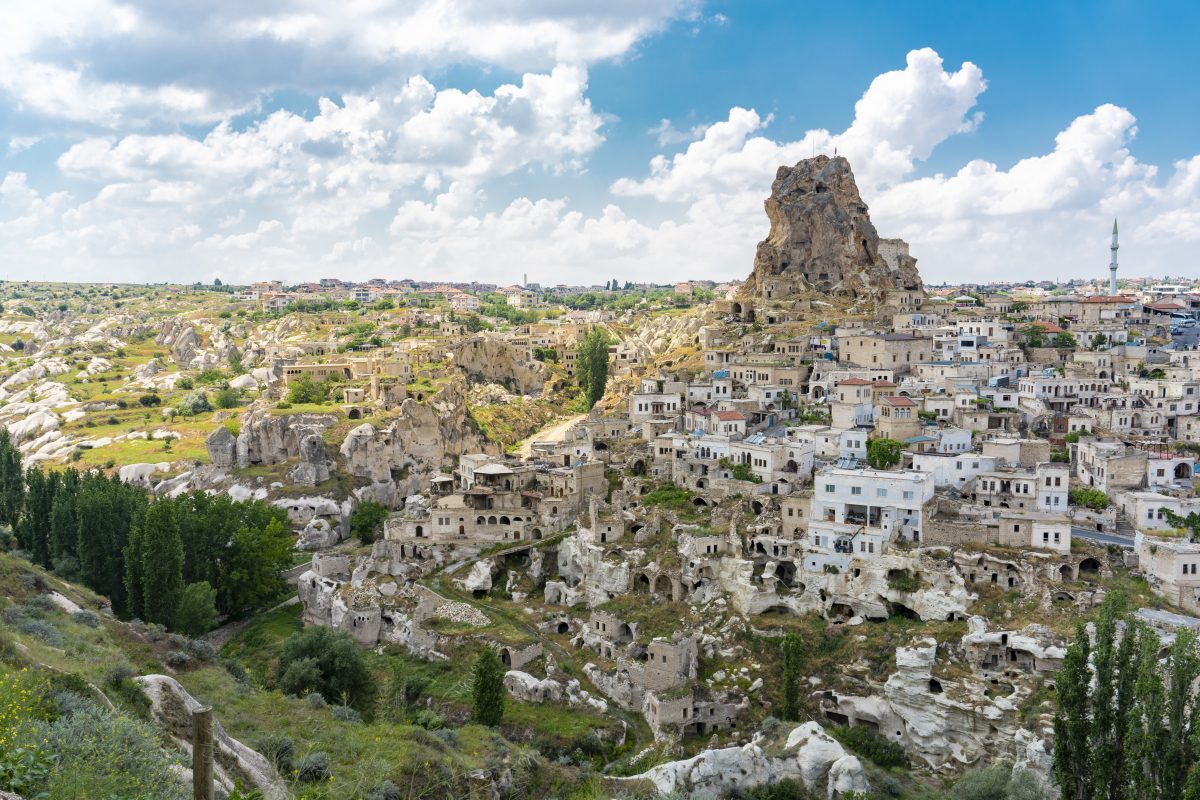
Ortahisar Castle, located in the town of Ortahisar in the Ürgüp district of Nevşehir Province, is one of the most striking structures in the Cappadocia region. Situated at an altitude of 1,200 meters and standing 86 meters tall, this castle is considered one of the largest fairy chimneys in the area. It began to be carved during the Hittite period (circa 1750–1200 BC) and was used throughout history as a strategic point for defense and shelter.
The castle consists of interconnected tunnels, rooms, and corridors. From its summit, visitors can enjoy a panoramic view of Ürgüp, Avanos, Göreme, and the surrounding valleys. Ortahisar Castle was opened to visitors in 2013 after a comprehensive restoration.
At the foot of the castle are stone houses and narrow streets, examples of Cappadocia’s characteristic civil architecture. Additionally, rock-carved storage areas in the region are used to keep locally grown produce such as potatoes and apples, as well as citrus fruits like oranges and lemons brought from the Mediterranean region.
Ortahisar Castle is a significant stop for visitors looking to explore the historical and natural beauty of Cappadocia. The sunset views from the top of the castle perfectly reflect the region’s enchanting atmosphere.
10. Çavuşin Village
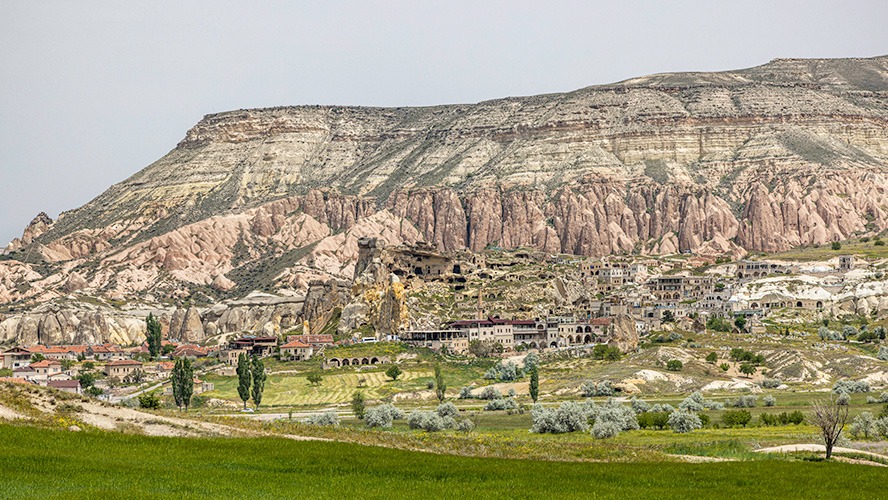
Çavuşin Village, located in the Avanos district of Nevşehir Province, is one of the oldest settlements in the Cappadocia region. Situated on the Göreme–Avanos road, it lies 5 km from Avanos and 17 km from Nevşehir. With a history dating back to the 1st century, the village was used during the Roman period as a place of refuge and worship for Christian monks.
Places to Visit
- Church of St. John the Baptist: Built in the 5th century, it is one of the oldest and largest churches in Cappadocia.
- Çavuşin Church (Church of Nikephoros Phocas): Constructed in the 10th century in honor of Byzantine Emperor Nikephoros Phocas.
- Paşabağ Valley: Located near Çavuşin, this valley is home to some of the most beautiful examples of fairy chimneys.
- Red Valley (Kızılçukur): Famous for its red-hued rocks at sunset, this valley is ideal for nature walks.
Activities
- Nature Walks: Çavuşin hosts some of the most popular hiking trails in Cappadocia.
- Horse and ATV Tours: Tours are available to explore the region’s natural beauty.
- Hot Air Balloon Rides: A popular activity for those who wish to view Cappadocia’s unique landscape from the sky.
Accommodation
Çavuşin offers authentic lodging options such as cave hotels and stone inns.
Food & Drink
The village has restaurants where visitors can taste traditional dishes of the Cappadocia region.
With its historical charm, natural beauty, and range of activities, Çavuşin Village is one of the must-see spots in Cappadocia.
11. Devrent Valley (Imagination Valley)

Devrent Valley, also known as Imagination Valley, is a unique natural formation located between the Avanos and Ürgüp districts of Cappadocia, along the Ürgüp road. The valley is especially famous for its fairy chimneys that resemble animal and human figures; the most well-known example is the camel-shaped rock formation.
Unlike other valleys in Cappadocia, Devrent Valley has never been inhabited and does not contain churches, monasteries, or underground cities. This makes it distinct and offers visitors the chance to witness nature’s creativity firsthand.
Although walking trails in Devrent Valley are limited, visitors can take short walks along marked paths to closely observe the fascinating rock formations. For photography enthusiasts, the valley offers enchanting views, especially at sunset.
Access to the valley is quite easy. After passing the Zelve Open-Air Museum on the Avanos–Ürgüp road, you can reach Devrent Valley. It is accessible by private vehicle or via local tours.
When visiting the valley, it is recommended to wear comfortable clothing and walking shoes. There are also small shops nearby where you can buy snacks and souvenirs.
This unique valley of Cappadocia is an ideal destination to explore nature’s artistic touches and let your imagination run free.
12. Ürgüp
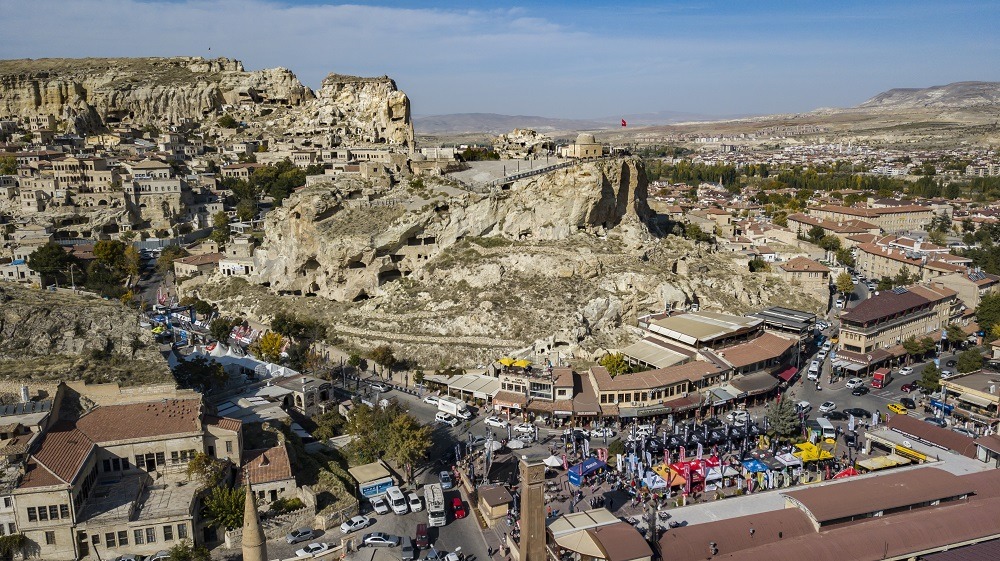
Ürgüp is one of the most important tourist centers in the Cappadocia region and is located in Nevşehir Province, Turkey. Situated 20 km east of Nevşehir, Ürgüp has hosted various civilizations throughout history and possesses a rich cultural heritage.
Historical and Cultural Attractions
- Temenni Hill: Located in the town center, this hill offers a panoramic view of Ürgüp and is home to historic tomb monuments.
- Three Beauties: One of Cappadocia’s most iconic fairy chimneys, these three formations are subjects of legends and attract many visitors.
- Keşlik Monastery: Located in the village of Cemil, about 15 km from Ürgüp, this monastery complex includes rock-carved churches, chapels, and monk cells.
- Asmalı Konak: This historic mansion, featured in a famous Turkish TV series, showcases traditional Cappadocian architecture and is open to visitors.
Natural Attractions
- Red Valley (Kızılçukur): Known for its red-colored rocks at sunset, this valley is ideal for hiking and photography.
- Fairy Chimneys: In and around Ürgüp, you can observe these unique rock formations shaped by nature over millions of years.
Activities
- Hot Air Balloon Rides: A popular activity for those wanting to view Cappadocia’s stunning landscape from above.
- Wine Tasting: Ürgüp is one of Turkey’s key wine production centers. You can enjoy tastings at local wineries and learn about the winemaking process.
- Horse and ATV Tours: These tours are ideal for adventure seekers wishing to explore the region’s natural beauty.
Accommodation and Dining
Ürgüp is known for its cave hotels and stone mansions. Local restaurants offer regional dishes as well as international cuisine options.
With its historical charm, natural beauty, and a wide range of activities, Ürgüp is one of the must-visit spots in Cappadocia.
13. Güvercinlik Valley

Güvercinlik Valley is an approximately 4-kilometer-long valley stretching between Uçhisar and Göreme in Cappadocia. It takes its name from the numerous pigeon houses carved into the rocks throughout the area. Historically, locals used pigeon droppings as natural fertilizer in vineyards, making pigeon breeding an important practice.
The valley is a popular route for nature walks. During the hike, visitors are treated to unique views of fairy chimneys, rock-carved pigeon houses, and lush vegetation. Additionally, the viewpoints overlooking the valley from Uçhisar Castle offer stunning vistas, especially at sunrise and sunset.
When hiking in Güvercinlik Valley, it is important to carry enough water, as water sources are limited within the valley. Also, following the red-marked trails at the entrance will help you stay on course more easily.
Güvercinlik Valley offers an immersive nature experience for visitors to Cappadocia and is an ideal destination for those looking to explore the region’s historical and natural beauty.
14. Red Valley (Kızılçukur Vadisi)

Red Valley (Kızılçukur Vadisi) is a captivating valley located within Göreme National Park in Cappadocia, between Ortahisar and Çavuşin Village. It takes its name from the red and pink hues of the tuff rocks, which become especially vivid at sunset. This natural display of color makes the valley a popular spot for visitors wishing to witness the sunrise and sunset.
Nature Walks and Activities
Red Valley offers ideal trails for nature walks and trekking. Spanning an area of approximately 1.5 kilometers, the valley provides scenic routes through vineyards, apricot trees, and almond groves. Along the way, hikers can discover historical cave churches such as the Church of Grapes (Üzümlü Kilise), the Church with Columns (Kolonlu Kilise), and the Church with the Cross (Haçlı Kilise).
Historical and Cultural Richness
The Church of Grapes, dating back to the 9th century, is a significant structure within the valley. It features a carved cross on its ceiling and wall decorations with red and green grape motifs. These frescoes, created before the iconoclasm period, reflect the region’s deep historical roots.
Sunset Views and Viewing Platforms
Red Valley offers one of Cappadocia’s most impressive sunset views. The viewing terraces in the valley allow visitors to witness the enchanting color transitions of the red tuff rocks as the sun sets. As such, it is an essential destination for photography lovers and those seeking a romantic atmosphere.
Access and Location
Red Valley is easily accessible due to its close proximity to central locations such as Göreme, Ortahisar, and Çavuşin. It can be reached by private vehicle or via local tours. The exploration typically begins at the trail leading to the Church of Grapes.
With its natural beauty, historical depth, and breathtaking views, Red Valley is one of Cappadocia’s must-see destinations. It offers an unforgettable experience through its scenic hikes, ancient churches, and stunning sunsets.
15. Love Valley (Aşk Vadisi)

Love Valley, also known as Bağlıdere Valley, is located near the town of Göreme in Cappadocia and is renowned for its uniquely shaped fairy chimneys. Famous for its unusual rock formations, the valley is a popular destination for nature walks and photography.
Legend and Name Origin
The name “Love Valley” is derived from the suggestive shapes of the fairy chimneys that spark imaginative associations. Additionally, the valley’s romantic atmosphere and its enchanting views at sunrise and sunset make it especially appealing to couples and photographers.
Geographic Location and Access
Love Valley is situated between Göreme and Avanos. It is accessible via a roughly 2-kilometer hike from Göreme. Visitors can also reach the valley through local tours or by renting a vehicle.
Activities
- Nature Walks: With a trail of about 5 kilometers, the valley is ideal for hiking. Along the way, visitors can enjoy a pleasant walk among fairy chimneys, vineyards, and fruit trees.
- Photography: The valley offers breathtaking views, especially at sunrise and sunset, making it a favorite spot for photography enthusiasts.
- Balloon Tours: Viewing the valley from above on one of Cappadocia’s famous hot air balloons is an unforgettable experience.
Visitor Tips
- Best Time to Visit: Sunrise and sunset are the best times to witness the valley’s most stunning views.
- Entrance Fee: Entry to the valley is free of charge.
- Preparation: Comfortable walking shoes and season-appropriate clothing are recommended.
Love Valley is a must-see destination for visitors seeking to explore the natural and cultural richness of Cappadocia.
16. Soğanlı Valley
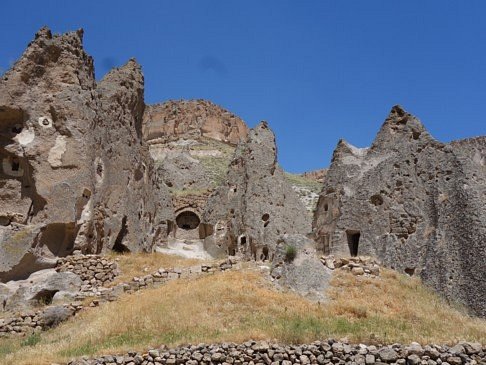
Soğanlı Valley is located in the Yeşilhisar district of Kayseri Province, in the southeastern part of the Cappadocia region. It is known for its historical and natural beauty, situated approximately 80 km from the city center of Kayseri and 40 km from Ürgüp.
Historical and Cultural Richness
Soğanlı Valley has been inhabited since the Roman period and became an important religious center during the Byzantine era. It is known that around 200 churches were carved into the rocks in the valley, although only a portion of them are open to visitors today.
Churches open to visitors include:
- Domed Church: A two-story structure adorned with frescoes, it took its final form in the 14th century.
- Karabaş Church: The nave is covered with a vault, and its frescoes depict scenes from the life of Jesus on a black background.
- Snake Church: Features frescoes with depictions of saints and snake figures.
- Tahtalı (St. Barbara) Church: Notable for its barrel-vaulted structure and frescoes depicting scenes from the New Testament.
Natural Beauty and Activities
The valley is filled with fascinating rock formations, pigeon houses, caves, and shelters. It offers an ideal setting for nature walks and photography. Additionally, the unique scenery of the area can be viewed from above through hot air balloon tours.
Local Products
Soğanlı Valley is also famous for its handmade cloth dolls. These dolls, crafted by local women, are among the most significant souvenirs reflecting the region’s cultural heritage.
Transportation
Soğanlı Valley can be reached by private vehicle. After arriving in Yeşilhisar from Kayseri city center, it takes about a 15 km drive to reach the valley.
With its historical texture, natural beauty, and cultural richness, Soğanlı Valley is one of Cappadocia’s hidden gems waiting to be discovered.
17. Mustafapaşa (Sinasos)

Mustafapaşa, formerly known as Sinasos, is a town in the Cappadocia region, located in the Ürgüp district of Nevşehir Province. Situated about 5 kilometers from Ürgüp, this charming town is renowned for its stone mansions, churches, and madrasahs, offering visitors a unique experience through its historical and cultural richness.
Historical and Cultural Richness
- Church of Saints Constantine and Helena: Located in the town center, this 19th-century church stands out with its wall decorations featuring vine motifs, twin-winged dragons, double-headed eagles, and angel figures.
- Mehmet Şakir Pasha Madrasah: Built in 1890, this madrasah is an educational structure from the Ottoman period and today houses part of Cappadocia University.
- Stone Mansions: The town has around 700 stone mansions, built in the late 19th century, with walls adorned with paintings. These mansions are notable for their craftsmanship and harmony with the local climate and topography.
Natural Attractions and Activities
- Gomeda Valley: Located southwest of Mustafapaşa, this valley is ideal for hiking and nature lovers. Visitors can explore rock-carved churches and pigeon houses throughout the valley.
- Vineyards and Wine Production: The region is also known for its vineyards and winemaking. Visitors can taste local wines and learn about the production process.
Transportation
Mustafapaşa is easily accessible. Located about 27 kilometers from the city center of Nevşehir, the town can be reached via a short drive through Ürgüp.
With its historical texture, architectural richness, and natural beauty, Mustafapaşa is one of Cappadocia’s hidden gems waiting to be discovered.
18. Mazı Underground City
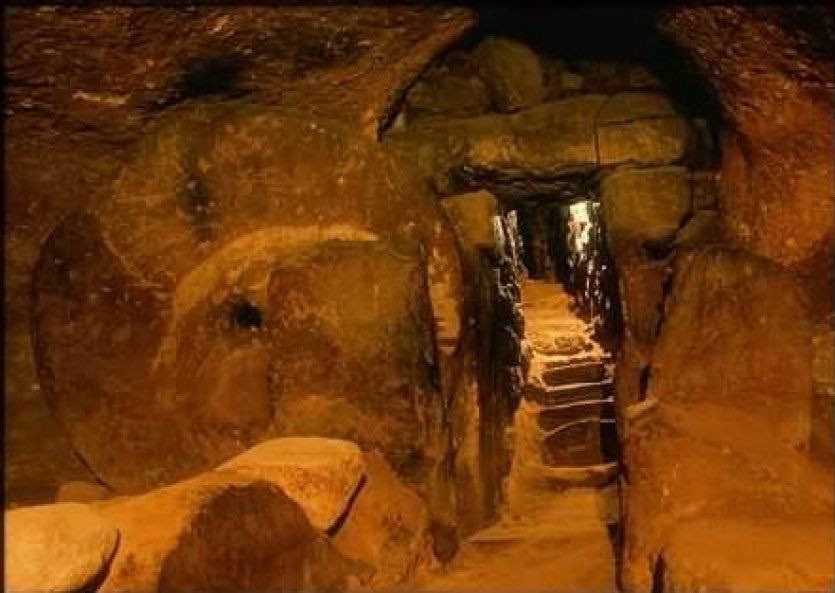
Mazı Underground City is one of the significant underground cities that reflect the rich historical fabric of the Cappadocia region. It is located in the village of Mazı, part of Nevşehir’s Ürgüp district, situated 18 km south of Ürgüp and 10 km east of Kaymaklı Underground City.
History: The ancient name of Mazı Village is “Mataza,” and its history dates back to the Hellenistic period. The village boasts a rich cultural heritage with its rock-carved churches, tombs, and ceramic kilns.
Architectural Features: Mazı Underground City has four different entrances. The main entrance is accessed through a corridor built of irregular stones, at the end of which lies a large rolling stone used to control access. The city includes stables, living quarters, a church, and storage rooms. The church can be reached through a short corridor from the stables, and its entrance is also designed to be sealed with a rolling stone.
Visitor Information
Address: Mazı Village, Ürgüp, Nevşehir
Visiting Hours
- Summer Season: 08:00 – 19:00 (Last ticket at 18:15)
- Winter Season: 08:00 – 17:00 (Last ticket at 16:15)
Entrance Fee: Museum Pass is accepted.
Mazı Underground City is an important stop among Cappadocia’s underground cities, offering a unique experience for those interested in history and culture.
19. Kaymaklı Underground City

Kaymaklı Underground City is one of the largest and most impressive underground cities in the Cappadocia region. It is located in the town of Kaymaklı in Nevşehir Province, about 20 kilometers from the city center. Opened to visitors in 1964, this underground city was used and expanded by various civilizations throughout history.
History: It is believed that the first level of Kaymaklı Underground City was built during the Hittite period around 3000 BC. During the Roman and Byzantine periods, it was expanded into an eight-level structure. Today, four of these levels are open to the public.
Architectural Features: Carved into tuff rock, the city consists of rooms and halls connected by narrow corridors. Inside are wine cellars, water cisterns, kitchens and food storage rooms, ventilation shafts, water wells, and a church. Large rolling stones were used to seal entrances from the inside to protect against external threats.
Visitor Information
Address: Kaymaklı Town, Nevşehir
Visiting Hours
- Summer Season: 08:00 – 19:00 (Last ticket at 18:15)
- Winter Season: 08:00 – 17:00 (Last ticket at 16:15)
Entrance Fee: Museum Pass is accepted.
Transportation: Kaymaklı Underground City can be reached by private vehicle or local tours from Nevşehir city center. Located on the Nevşehir–Niğde highway, Kaymaklı is about 20 kilometers away from the center.
Kaymaklı Underground City is a must-see destination for visitors wishing to explore Cappadocia’s rich history and unique architecture.
20. Gomeda Valley

Gomeda Valley is one of Cappadocia’s hidden natural and historical treasures. It is located about 2 kilometers southwest of Mustafapaşa, a town in Nevşehir’s Ürgüp district, and north of Ayvalı Village. The valley is notable for its rich vegetation, intriguing rock formations, and historical remnants.
Historical and Cultural Richness
Historically known as “Kanavuria,” Gomeda Valley once housed around 600 households. The valley is known to contain two churches, two necropolises (cemeteries), and an underground city. The Alakara Church and the Church of Saint Basil are among the significant religious structures in the valley, drawing attention with their frescoes and architectural details.
Natural Beauty and Activities
With a hiking trail of approximately 6 kilometers, the valley is ideal for nature walks. Along the trail, visitors can see rock-carved pigeon houses, caves, and vineyards. The path follows the Üzengi Stream, offering nature lovers a pleasant experience with wooden bridges and lush green surroundings.
Access
Gomeda Valley can be reached via Mustafapaşa. The entrance to the valley is accessible from the Cumhuriyet Square in Mustafapaşa. Alternatively, visitors can follow the road to Ayvalı Village. From the 2.7-kilometer mark on the Ürgüp–Mustafapaşa road, turn toward Ayvalı, and after about 2 kilometers, a sign reading “Gomeda Harabeleri Vadisi” will appear on the right.
Visitor Tips
Preparation: Visitors planning to hike in the valley are advised to wear comfortable shoes and bring sufficient water.
Guided Tours: To better understand the region and ensure a safe visit, local guide services can be helpful.
Accommodation: Various lodging options are available in Mustafapaşa and Ürgüp.
Gomeda Valley is a unique destination for visitors seeking to explore the natural and historical essence of Cappadocia.
21. Three Beauties (Üç Güzeller)
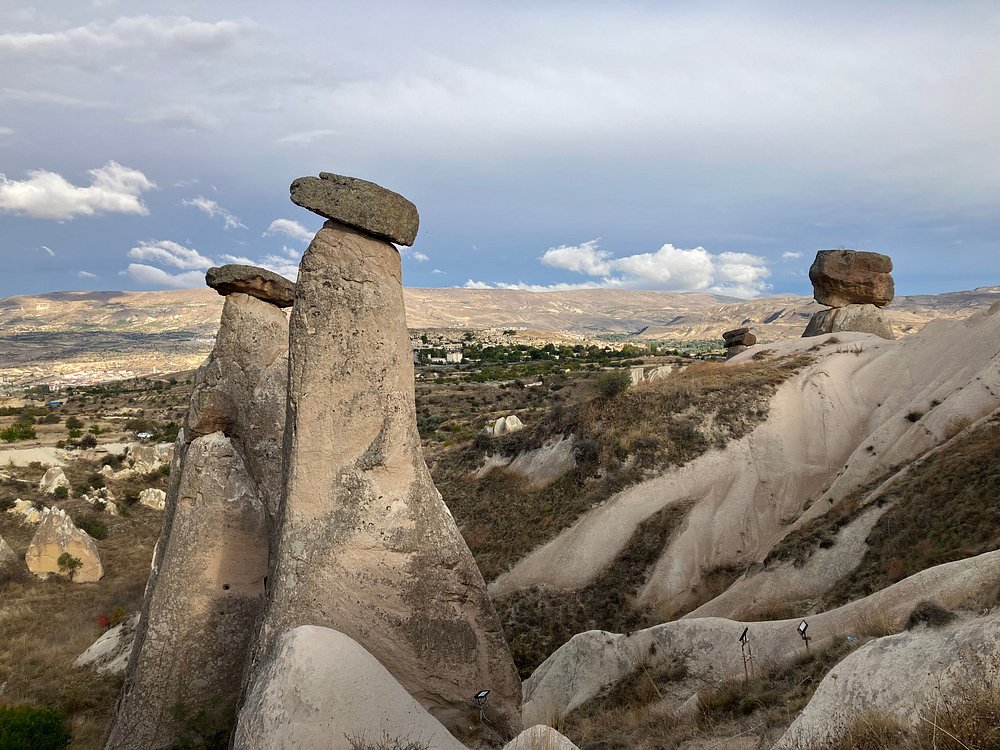
The Three Beauties (Üç Güzeller) is a natural rock formation consisting of three fairy chimneys located in the Ürgüp district of Cappadocia. These iconic formations—two large and one smaller chimney positioned side by side—are named for their resemblance to a nuclear family.
Legends
Love Story Legend: According to legend, the beautiful daughter of a Cappadocian king falls in love with a shepherd. The king disapproves of their relationship, but the princess runs away with her lover and marries him. After having a child, she hopes for her father’s forgiveness and returns to the palace. However, the king, in a fit of rage, orders his soldiers to capture them. Cornered during their escape, the family prays to God, and a miracle turns them into stone. The three chimneys are believed to represent the shepherd in front, the child in the middle, and the princess behind.
Fairies and Humans Legend: Another tale tells of a time when fairies and humans lived in harmony. Gülperi, the daughter of the fairy king, falls in love with Revan, the son of a human king. Humans oppose their love and declare war on the fairies. Instead of fighting, the fairy king chooses to leave the region, turning the fairies into pigeons to stay among the humans. Gülperi transforms into a white pigeon and lands on Revan’s window, but he, thinking she has left forever, waits for her for the rest of his life.
Geographical Location and Access
The Three Beauties are located on the Nevşehir–Ürgüp road, just about a 5-minute drive from the center of Ürgüp. The site is easily accessible by private car or public transportation. From the viewpoint, visitors can also enjoy a scenic panorama that includes Mount Erciyes in the background.
Natural Formation
The Three Beauties were formed over millions of years by natural erosion processes. The soft tuff and volcanic rocks of the region were shaped into their unique conical forms by wind and water erosion.
Visitor Information
- Entrance Fee: Visiting the Three Beauties is free of charge.
- Best Time to Visit: Sunrise and sunset offer the most beautiful lighting conditions for viewing and photography.
- Activities: It’s a popular spot for photography. Visitors can also purchase handmade items from souvenir stalls nearby.
The Three Beauties is one of Cappadocia’s most unique natural wonders, offering a stunning visual experience along with rich legends and cultural heritage.
22. Hacı Bektaş Veli Museum

The Hacı Bektaş Veli Museum is located in the Hacıbektaş district of Nevşehir Province and was established by converting a 13th-century dervish lodge founded by the Turkish mystic Hacı Bektaş Veli into a museum. After his death, the complex was expanded during the reigns of Ottoman sultans Orhan Gazi, Yıldırım Bayezid, and Yavuz Sultan Selim, and it underwent restorations during the periods of Sultan Mustafa IV, Sultan Abdülaziz, and Sultan Abdülhamid II to reach its current form.
Museum Sections
- First Courtyard (Nadar Courtyard): Located at the entrance, this area once contained the living quarters of dervishes, horse stables, and food storage rooms.
- Second Courtyard (Dervish Courtyard): This section includes structures such as the Aslanlı Fountain, soup kitchen, ceremonial hall (Meydan Evi), mosque, and guesthouse.
- Third Courtyard (Sanctuary Courtyard): This area houses the tomb of Hacı Bektaş Veli, the tomb of Balım Sultan, and the Square of the Forty (Kırklar Meydanı).
Visitor Information
Address: Zir Neighborhood, Hacı Bektaşi Veli Boulevard No:5, 50800 Hacıbektaş/Nevşehir
Phone: +90 384 441 30 22
Visiting Hours
- Summer Season (April 15 – October 2): 08:00 – 19:00
- Winter Season (October 3 – April 14): 08:00 – 17:00
Entrance Fee: Free of charge
Transportation
The district of Hacıbektaş is located approximately 45 km from the city center of Nevşehir. There are regular bus services from Nevşehir to Hacıbektaş. For those traveling by private vehicle, parking is available near the museum.
Note: The museum experiences a high number of visitors during the Hacı Bektaş Veli Commemoration Ceremonies and Cultural Arts Events held annually from August 16–18. Visitors planning to attend during this period are advised to make accommodation and transportation arrangements in advance.
23. Nevşehir Castle
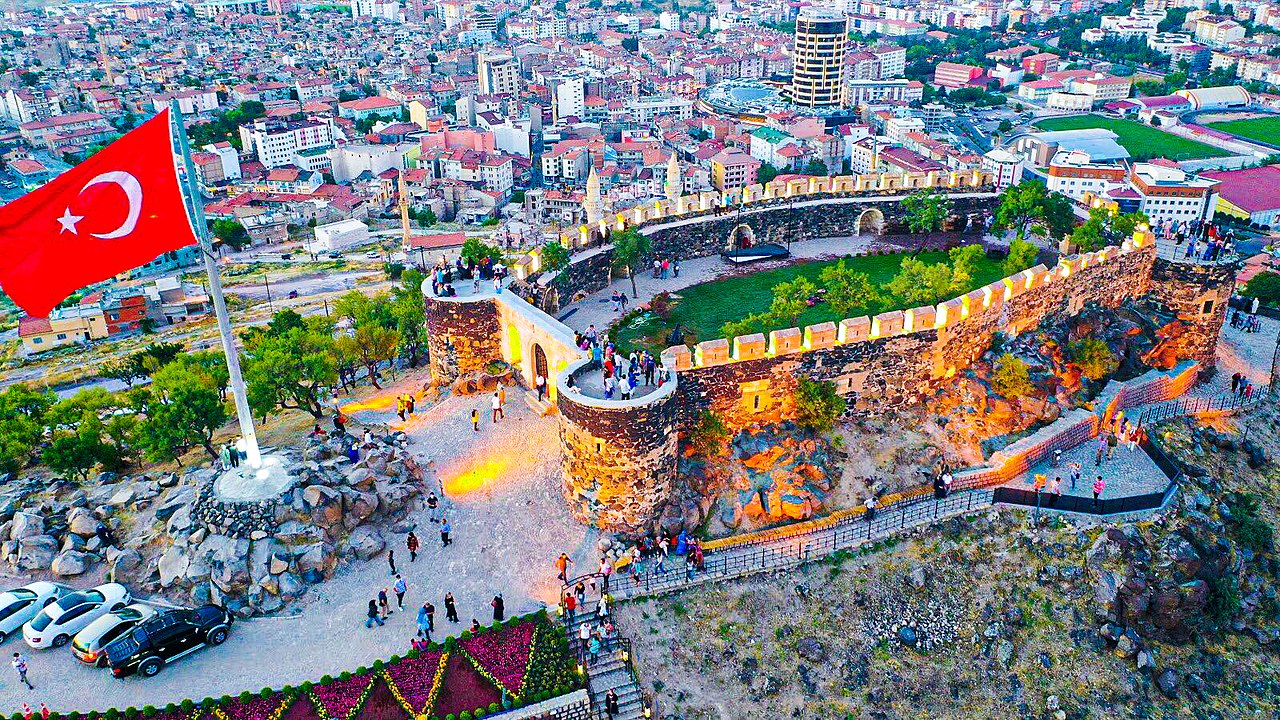
Nevşehir Castle is a historical fortress located in the city center of Nevşehir, Turkey, situated on a hill in the southwest of the city at an elevation of 1,285 meters. Although the exact date of its construction is unknown, its architectural style suggests that it was built during the Byzantine period.
The castle has an asymmetrical layout and features two entrance gates on the east and west sides. The west gate has a round arch and measures 2.10 meters in width and 2.45 meters in height. The east gate has a rectangular form, measuring 1.52 meters in width and 3.40 meters in height.
Beneath the castle lies a vast underground city known as Kayaşehir. This underground complex consists of tunnels and rooms and is considered one of the largest of its kind in the region.
Nevşehir Castle has been used by various civilizations throughout history and has undergone repairs during different periods. Today, efforts continue to restore and open both the castle and the underground city below it to tourism.
Visitors can explore the castle and its surroundings to witness the rich historical heritage of Nevşehir.
24. Güllüdere Valley

Güllüdere Valley, located between Göreme and Çavuşin Village in Cappadocia, stretches for approximately 4 kilometers and is one of the region’s most popular hiking trails. The valley takes its name from the rose-colored hue the rocks take on when illuminated by daylight, offering enchanting views especially at sunrise and sunset.
Historical and Cultural Richness
Throughout history, Güllüdere Valley has hosted various civilizations and contains five rock-carved churches:
- Yovakim–Anna Church: Dedicated to the Virgin Mary’s parents, it is notable for its rare fresco of the Virgin Mary.
- Columned Church (Direkli Kilise): Known for the interior columns and distinctive architectural design.
- Ayvalı Church: Comprises two chapels; the northern one was used as a tomb.
- Church with the Cross (Haçlı Kilise): Known for the cross motifs on its ceiling and dates back to the 6th or 7th century.
- Church of the Three Crosses (Üç Haçlı Kilise): Features three cross carvings on the ceiling and is famous for its frescoes.
Natural Beauty and Activities
In spring, blooming almond and apricot trees provide a unique atmosphere for nature lovers. Güllüdere Valley is one of the best routes to observe fairy chimney formations and is ideal for photography and trekking enthusiasts.
Access
There are two main entry points to Güllüdere Valley:
- Çavuşin Village Entrance: After passing the mosque and cemetery in the village, follow the signs marked “Güllüdere” to reach the valley.
- Göreme Entrance: From Göreme, it is possible to access Güllüdere via the Meskendir Valley.
Visitor Tips
- Best Time to Visit: Sunrise and sunset offer breathtaking views, especially for photographers.
- Preparation: Comfortable walking shoes and water are highly recommended.
- Guided Tours: To fully explore the valley’s historical and natural beauty, consider hiring a local guide.
Güllüdere Valley is one of Cappadocia’s rare locations where natural and historical treasures coexist, offering visitors an unforgettable experience.
25. Cappadocia Balloon Tour
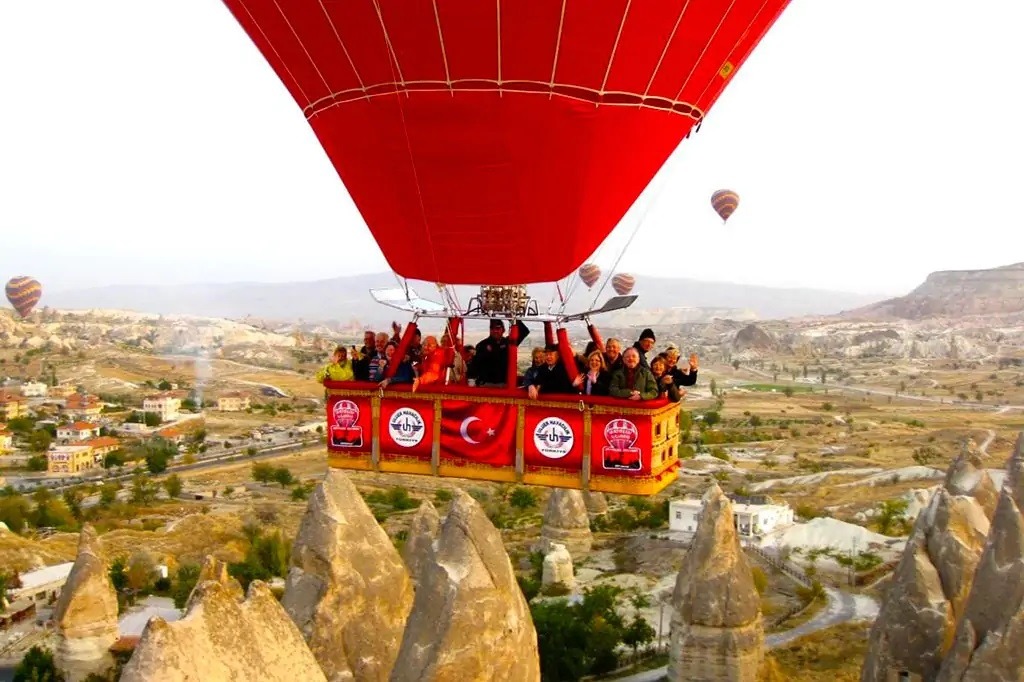
The Cappadocia Balloon Tour is a unique experience that has become a symbol of the region and is considered one of the most iconic aerial activities in the world. As the hot air balloons rise with the sunrise and silently glide over Cappadocia’s unique fairy chimneys, valleys, and historical landscape, they offer visitors a dreamlike view.
General Information About the Balloon Tour
- Departure Time: Usually just before sunrise (around 05:00 – 06:00).
- Duration: The flight lasts about 1 hour (some deluxe tours may extend to 90 minutes).
- Take-off Points: Areas near Göreme, Uçhisar, Avanos, and Çavuşin.
- Scenery: Iconic sights such as the fairy chimneys, Ihlara and Pigeon valleys, Three Beauties, and Uçhisar Castle can be viewed from above.
- Safety: Pilots are licensed in accordance with civil aviation regulations; balloons undergo meticulous checks before every flight.
- Price: Varies by season and tour package, generally between €150–300 per person.
Tour Packages Typically Include
- Hotel pickup and drop-off
- Light breakfast
- Flight certificate and champagne celebration after landing
- Insurance and safety equipment
Tips for the Balloon Tour
- Make early reservations, as spots fill up quickly.
- Dress warmly, especially for the chilly early morning hours.
- Bring a fully charged camera or phone—there are excellent photo opportunities!
The Cappadocia Balloon Tour is considered one of the most spectacular experiences not only in Turkey but worldwide. Floating in the sky and witnessing this fairytale landscape from above becomes an unforgettable memory.
26. Cappadocia Art and History Museum (Ürgüp)

The Cappadocia Art and History Museum is a private museum located in the town of Mustafapaşa (formerly Sinasos), part of Ürgüp district in Nevşehir. Housed in a 170-year-old historical mansion, it holds the distinction of being Turkey’s first handmade doll museum.
Museum Features
- Collection: The museum displays around 3,000 handmade kitre dolls. These dolls are presented in thematic scenes reflecting Anatolian traditions, customs, historical figures, and professions. Notable characters such as Yunus Emre, Mevlana, Nasreddin Hodja, Âşık Veysel, Dede Korkut, Hacı Bektaş Veli, Köroğlu, and Koca Yusuf are brought to life, along with depictions of Ottoman sultans and palace life.
- Museum Building: The museum is housed in a restored mansion with its original architecture preserved. Elements such as wall paintings, carved stone niches, a traditional oven (tandır), cupboards, and seating areas (sedir) also attract visitors’ attention.
Visitor Information
- Address: Yukarı Mahalle, Gazi Sokak No:6, 50400 Mustafapaşa Village, Ürgüp, Nevşehir, Turkey
- Phone: +90 384 353 52 21
Visiting Hours
- Monday: Closed
- Tuesday – Sunday: 10:00 – 18:00
Entrance Fee: Admission is charged. Please contact the museum for student and group discounts.
Transportation
Mustafapaşa is approximately 30 km from Nevşehir city center and 5 km from Ürgüp. Nevşehir Airport is served by airlines such as Turkish Airlines, AnadoluJet, and Pegasus. For those traveling by road, the distances are 276 km to Ankara, 764 km to Istanbul, and 779 km to Izmir.
Additional Services
The museum complex also includes a boutique hotel for accommodation, a café for relaxation, and workshops for adults, such as puppet making, clay doll crafting, wood painting, and art classes.
The Cappadocia Art and History Museum offers a unique visual experience for those wishing to explore Anatolia’s rich cultural heritage and history through handmade dolls.
27. Avanos Hair Museum

The Avanos Hair Museum is a unique location in the Avanos district of Cappadocia and is considered one of the most unusual museums in the world. Founded in 1979 by local pottery master Galip Körükçü, the museum houses hair locks from more than 16,000 women.
Museum Story
The museum’s origin dates back to 1979 when a French female tourist, upon leaving Galip Körükçü’s workshop, left a lock of her hair to be remembered by. Inspired by this gesture, other female visitors began leaving their hair as well, eventually transforming the site into the museum it is today.
Museum Features
- Collection: The museum contains hair locks from over 16,000 women and was listed in the Guinness World Records in 1998.
- Venue: It is located inside a 500-square-meter cave carved from rock, with interconnecting rooms.
- Events: Every June and December, a lottery is held among the women who have donated their hair, and 10 winners are awarded a one-week vacation in Cappadocia.
Visitor Information
- Address: Yeni Mahalle, Hasan Kalesi Mevkii 3, Avanos – Nevşehir
- Visiting Hours: Open daily from 08:30 to 19:30
- Entrance Fee: As of 2024, the fee is 50 TL per person
Transportation
Avanos is located about 18 km from Nevşehir city center. It can be reached from Göreme in about 5 minutes by private car. The museum is situated in the town square of Avanos, close to other local attractions.
With its extraordinary concept and fascinating backstory, the Avanos Hair Museum is one of the must-see sites in the Cappadocia region.
28. Zemi Valley

Zemi Valley is a 5.6-kilometer-long valley located near the town of Göreme in Cappadocia, and is a popular route for nature lovers.
Natural Beauty and Activities
- Hiking Trail: The valley is surrounded by rich vegetation and impressive rock formations, and during the hike, you can encounter various fruit trees and small streams.
- Historical Churches: On the hiking route, there are historical structures such as Sarnıç Church, Hidden Church, Görkündere Church, and El Nazar Church.
Transportation
You can enter Zemi Valley via the Göreme Open-Air Museum road or from the Babacık area on the 10th kilometer of the Nevşehir-Ürgüp highway.
Visitor Tips
- Preparation: Comfortable hiking shoes are recommended, and it is advised to bring enough water.
- Best Time to Visit: Spring and autumn months are the most suitable periods for hiking.
Zemi Valley offers a unique experience for those looking to explore both the natural and historical riches of Cappadocia.
29. Taşkınpaşa Medresesi
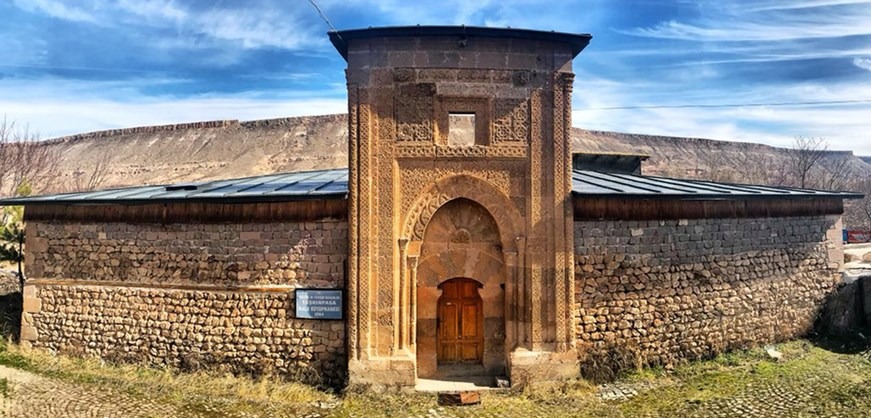
Taşkınpaşa Medrese, located in Taşkınpaşa Village, Ürgüp district of Nevşehir, is an important educational and cultural structure built during the 14th century, in the period of the Karamanid Dynasty. The medrese is part of a külliye that includes a mosque, mausoleum, and tomb.
Architectural Features
- Plan: The medrese has a square layout and was constructed using cut stone and rubble stone.
- Entrance Gate: The most striking part of the medrese is the protruding and high entrance gate on the west facade. It is decorated with geometric and plant motifs and is a beautiful example of Seljuk stone craftsmanship.
- Floor Status: The building is believed to have originally been two stories.
History and Function
Although the exact construction date is unknown because the inscription has not survived, based on the inscriptions of other structures in the külliye, it is thought to have been built in the mid-14th century. The building, which had fallen into disrepair over time, has been restored and now serves as a public library.
Transportation
Taşkınpaşa Medrese is located in the center of Taşkınpaşa Village, approximately 20 km from Ürgüp, on the Ürgüp-Soğanlı road.
This historical structure is an important example reflecting the architectural and cultural richness of the Anatolian Seljuk and Karamanid periods, making it a must-see for visitors to the region.
30. Üzengi Valley

Üzengi Valley is a valley located between Ürgüp district and Ortahisar town in Cappadocia, known for its natural and historical richness. It provides an ideal setting for activities such as nature walks, picnics, and photography.
Natural Beauty and Activities
- Pigeon Houses: Throughout the valley, there are numerous pigeon houses carved into the rocks. These structures, once used for collecting pigeon droppings for agricultural purposes, reflect the region’s cultural heritage.
- Üzengi Stream: The Üzengi Stream running through the valley offers visitors a cool atmosphere. You can enjoy a picnic by the stream or simply immerse yourself in nature.
- Healing Mineral Waters: The valley is known for its iron-scented and carbonated mineral water springs. These waters are said to be beneficial for digestive disorders and kidney problems.
Historical and Cultural Richness
Rock Churches: Along the valley, there are rock churches known for their frescoes and architecture. These churches shed light on the region’s historical and religious past.
Transportation
To reach Üzengi Valley, take the Mustafapaşa road from Ürgüp, and after about 2.5 kilometers, turn towards Ayvalı Village. Continue for about 2 kilometers, and on the right, you will see a sign for “Gomeda Harabeleri.” Follow this sign to reach the valley.
Visitor Tips
- Hiking Trails: The valley is suitable for hiking. However, since some of the paths are dirt, be cautious during rainy weather.
- Preparation: It is recommended to bring water and snacks for a comfortable hiking experience.
Üzengi Valley is a must-visit destination for visitors wishing to explore both the natural beauty and historical heritage of Cappadocia.
